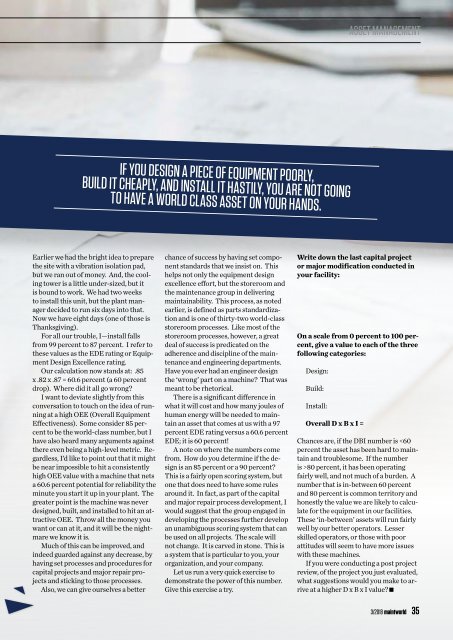Maintworld 3/2018
Are You Overlooking a Significant Source of Savings? // Advantages of broadband ultrasonic analysis // Are you in the “circle of despair”? // Future of work
Are You Overlooking a Significant Source
of Savings? // Advantages of broadband ultrasonic analysis // Are you in the “circle of despair”? // Future of work
You also want an ePaper? Increase the reach of your titles
YUMPU automatically turns print PDFs into web optimized ePapers that Google loves.
asset management<br />
If you design a piece of equipment poorly,<br />
BUild it cheaply, and install it hastily, you are not going<br />
to have a world class asset on your hands.<br />
Earlier we had the bright idea to prepare<br />
the site with a vibration isolation pad,<br />
but we ran out of money. And, the cooling<br />
tower is a little under-sized, but it<br />
is bound to work. We had two weeks<br />
to install this unit, but the plant manager<br />
decided to run six days into that.<br />
Now we have eight days (one of those is<br />
Thanksgiving).<br />
For all our trouble, I—install falls<br />
from 99 percent to 87 percent. I refer to<br />
these values as the EDE rating or Equipment<br />
Design Excellence rating.<br />
Our calculation now stands at: .85<br />
x .82 x .87 = 60.6 percent (a 60 percent<br />
drop). Where did it all go wrong?<br />
I want to deviate slightly from this<br />
conversation to touch on the idea of running<br />
at a high OEE (Overall Equipment<br />
Effectiveness). Some consider 85 percent<br />
to be the world-class number, but I<br />
have also heard many arguments against<br />
there even being a high-level metric. Regardless,<br />
I’d like to point out that it might<br />
be near impossible to hit a consistently<br />
high OEE value with a machine that nets<br />
a 60.6 percent potential for reliability the<br />
minute you start it up in your plant. The<br />
greater point is the machine was never<br />
designed, built, and installed to hit an attractive<br />
OEE. Throw all the money you<br />
want or can at it, and it will be the nightmare<br />
we know it is.<br />
Much of this can be improved, and<br />
indeed guarded against any decrease, by<br />
having set processes and procedures for<br />
capital projects and major repair projects<br />
and sticking to those processes.<br />
Also, we can give ourselves a better<br />
chance of success by having set component<br />
standards that we insist on. This<br />
helps not only the equipment design<br />
excellence effort, but the storeroom and<br />
the maintenance group in delivering<br />
maintainability. This process, as noted<br />
earlier, is defined as parts standardization<br />
and is one of thirty-two world-class<br />
storeroom processes. Like most of the<br />
storeroom processes, however, a great<br />
deal of success is predicated on the<br />
adherence and discipline of the maintenance<br />
and engineering departments.<br />
Have you ever had an engineer design<br />
the ‘wrong’ part on a machine? That was<br />
meant to be rhetorical.<br />
There is a significant difference in<br />
what it will cost and how many joules of<br />
human energy will be needed to maintain<br />
an asset that comes at us with a 97<br />
percent EDE rating versus a 60.6 percent<br />
EDE; it is 60 percent!<br />
A note on where the numbers come<br />
from. How do you determine if the design<br />
is an 85 percent or a 90 percent?<br />
This is a fairly open scoring system, but<br />
one that does need to have some rules<br />
around it. In fact, as part of the capital<br />
and major repair process development, I<br />
would suggest that the group engaged in<br />
developing the processes further develop<br />
an unambiguous scoring system that can<br />
be used on all projects. The scale will<br />
not change. It is carved in stone. This is<br />
a system that is particular to you, your<br />
organization, and your company.<br />
Let us run a very quick exercise to<br />
demonstrate the power of this number.<br />
Give this exercise a try.<br />
Write down the last capital project<br />
or major modification conducted in<br />
your facility:<br />
On a scale from 0 percent to 100 percent,<br />
give a value to each of the three<br />
following categories:<br />
Design:<br />
Build:<br />
Install:<br />
Overall D x B x I =<br />
Chances are, if the DBI number is 80 percent, it has been operating<br />
fairly well, and not much of a burden. A<br />
number that is in-between 60 percent<br />
and 80 percent is common territory and<br />
honestly the value we are likely to calculate<br />
for the equipment in our facilities.<br />
These ‘in-between’ assets will run fairly<br />
well by our better operators. Lesser<br />
skilled operators, or those with poor<br />
attitudes will seem to have more issues<br />
with these machines.<br />
If you were conducting a post project<br />
review, of the project you just evaluated,<br />
what suggestions would you make to arrive<br />
at a higher D x B x I value?<br />
3/<strong>2018</strong> maintworld 35

















